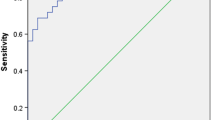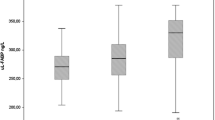Abstract
Background
Reflux nephropathy is the most serious complication of vesicoureteral reflux (VUR). The aim of this study was to assess the role of urinary levels of neutrophil-gelatinase-associated lipocalin (NGAL),kidney injury molecule-1 (KIM-1), and liver-type fatty-acid-binding protein (L-FABP) in the early diagnosis of reflux nephropathy in patients with VUR.
Methods
This study assessed 123 patients with primary VUR and 30 healthy children as a control group. The children were divided into five groups: Group A, patients with VUR and renal parenchymal scarring (RPS); Group B, patients with VUR and without RPS; Group C, patients with RPS and resolved VUR; Group D, patients with resolved VUR and without RPS; Group E, healthy reference group.
Results
Median urinary NGAL (uNGAL)/Creatinine (Cr) was significantly higher in patients with than those without RPS and the control group (p = 0.0001). Median uKIM-1/Cr was similar in all groups (p = 0.417). Median uL-FABP/Cr was significantly higher in patients with RPS than in the reference group (p < 0.05).
Conclusions
Urinary NGAL levels may be used as a noninvasive diagnostic marker for predicting renal scarring in reflux nephropathy.





Similar content being viewed by others
References
Hellerstein S (2000) Long-term consequences of urinary tract infections. Curr Opin Pediatr 12:125–128
Lebowitz RL (1992) The detection and characterization of vesicoureteric reflux in the child. J Urol 148:1640–1642
Sargent MA (2000) What is the normal prevalence of vesicoureteric reflux? Pediatr Radiol 30:587–593
Faust WC, Diaz M, Pohl HG (2009) Incidence of post-pyelonephric renal scarring: a meta-analysis of the dimercapto-succinic acid literature. J Urol 181:290–297
Bek K, Akman S, Bilge I, Topaloğlu R, Calişkan S, Peru H, Cengiz N, Soylemezoğlu O (2009) Chronic kidney disease in children in Turkey. Pediatr Nephrol 24:797–806
Flower DR (1996) The lipocalin protein family: structure and function. Biochem J 318:1–14
Mishra J, Ma Q, Prada A, Mitsnefes M, Zahedi K, Yang J, Barasch J, Devarajan P (2003) Identification of neutrophil gelatinase-associated lipocalin as a novel early urinary biomarker for ischemic renal injury. J Am Soc Nephrol 14:2534–2543
Devarajan P (2008) Neutrophil gelatinase-associated lipocalin (NGAL): a new marker of kidney disease. Scand J Clin Lab Investig Suppl 241:89–94
Wasilewska A, Taranta-Janusz K, Debek W, Zoch-Zwierz W, Kuroczycka-Saniutycz E (2011) KIM-1 and NGAL: new marker of obstructive nephropathy. Pediatr Nephrol 26:579–586
Waring WS, Moonie A (2011) Earlier recognition of nephrotoxicity using novel biomarkers of acute kidney injury. Clin Toxicol 49:720–728
Han WK, Waikar SS, Johnson A, Betensky RA, Dent CL, Devarajan P, Bonventre JV (2008) Urinary biomarkers in the early diagnosis of acute kidney injury. Kidney Int 73:863–869
Van Timmeren MM, Van den Heuvel MC, Bailly V, Bakker SJ, van Goor H, Stegeman CA (2007) Tubular kidney injury molecule-1 (KIM-1) in human renal disease. J Pathol 212:209–217
Yamamoto T, Noiri E, Ono Y, Doi Y, Doi K, Negishi K, Kamijo A, Kimura K, Fujita T, Kinukawa T, Taniguchi H, Nakamura K, Goto M, Shinozaki N, Ohshima S, Sugaya T (2007) Renal L-type fatt acid-binding protein in acute ischemic injury. J Am Soc Nephrol 18:2894–2902
Lebowitz RL, Olbing H, Parkkulainen KV, Smellie JM, Tamminen-Mobius TE (1985) International Reflux Study in Children: international system of radiographic grading of vesicoureteral reflux. Pediatr Radiol 15:105–109
Imperiale A, Olianti C, Sestini S, Materassi M, Daniela S, Ienuso R, La Cava G (2003) 123I-Hippuran renal scintigraphy with evaluation of single-kidney clearance for predicting renal scarring after acute urinary tract infection: comparison with 99mTc-DMSA scanning. J Nucl Med 44:1755–1760
Ichino M, Mamoru K, Kuroyanagi Y, Mori T, Morooka M, Sasaki H, Shiroki R, Shishido S, Kurahashi H, Hoshinaga K (2010) Urinary neutrophil gelatinase-associated lipocalin is a potential noninvasive marker for renal scarring in patients with vesicoureteral reflux. J Urol 183:2001–2007
Ichino M, Kuroyanagi Y, Mamoru K, Mori T, Ishikawa K, Shiroki R, Kurahashi H, Hoshinaga K (2009) InCreased urinary neutrophil gelatinase-associated lipocalin levels in a rat model of upper urinary tract infection. J Urol 181:2326–2331
Devarajan P (2008) Emerging urinary biomarkers in the diagnosis of acute kidney injury. Expert Opin Med Diagn 2:387–398
Vaidya VS, Ramirez V, Ichimura T (2006) Urinary kidney injury molecule-1: a sensitive quantitative biomarker for early detection of kidney tubular injury. Am J Physiol Ren Physiol 290:517–529
Han WK, Bailly V, Abichandani R, Thadhani R, Bonventre JV (2002) Kidney Injury Molecule-1 (KIM-1): a novel biomarker for human renal proximal tubule injury. Kidney Int 62:237–244
Ichimura T, Hung CC, Yang SA, Stevens JL, Bonventre JV (2004) Kidney injury molecule-1: a tissue and urinary biomarker for nephrotoxicant-induced renal injury. Am J Physiol Ren Physiol 286:552–563
Toker A, Ziypak T, Orsal E, Laloğlu E, Bedri F, Aksoy Y (2013) Is urinary kidney injury molecule-1 a noninvasive marker for renal scarring in children with vesicoureteral reflux? Urology 81:168–172
Nakamura T, Sugaya T, Koide H (2009) Urinary liver-type fatty acid-binding protein in septic shock: effect of polymyxin B-immobilized fiber hemoperfusion. Shock 31:454–459
Yokoyama T, Kamijo-Ikemori A, Sugaya T, Hoshino S, Yasuda T, Kimura K (2009) Urinary excretion of liver type fatty acid binding protein accurately reflects the degree of tubulointerstitial damage. Am J Pathol 174:2096–2106
Mou S, Wang Q, Li J, Shi B, Ni Z (2012) Urinary excretion of liver-type fatty acid-binding protein as a marker of progressive kidney function deterioration in patients with chronic glomerulonephritis. Clin Chim Acta 413:187–191
Conflict of interest
There is no conflict of financial interest to disclose.
Ethics statement
This study was approved by the Başkent University Institutional Review Board and Ethics Committee (Project no: KA11/153) and supported by Başkent University Research Fund. All participants were investigated after obtaining written informed consent from all parents following explanation of the purpose of the study.
Author information
Authors and Affiliations
Corresponding author
Rights and permissions
About this article
Cite this article
Parmaksız, G., Noyan, A., Dursun, H. et al. Role of new biomarkers for predicting renal scarring in vesicoureteral reflux: NGAL, KIM-1, and L-FABP. Pediatr Nephrol 31, 97–103 (2016). https://doi.org/10.1007/s00467-015-3194-3
Received:
Revised:
Accepted:
Published:
Issue Date:
DOI: https://doi.org/10.1007/s00467-015-3194-3




